A Review of the Criteria for Locating of Solar Power Plants in Iran
Solar Power Ontario (2021 Guide)
Congratulations! You've found the ultimate guide for installing solar power in Ontario!
Published by Rylan Urban on Feb 15, 2018. Terminal updated May 1, 2021.
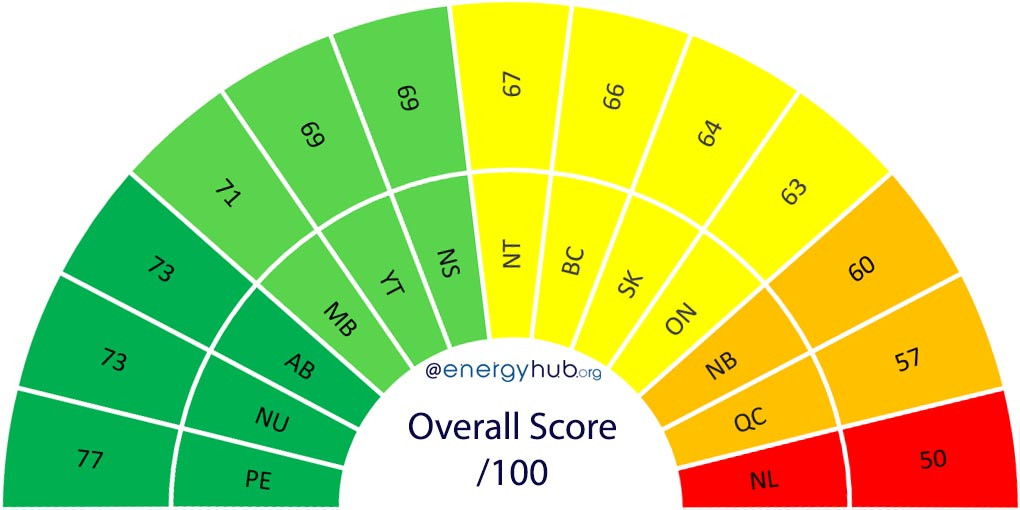
Ontario is currently ranked the #9 province in the country for installing a solar power system, scoring as one of the best provinces for upfront system costs and financing options.
This page contains all relevant data most installing solar in Ontario including utility policies, system financing, solar incentives, and natural factors – updated as of May 1st, 2021.
The guide begins by answering the two most mutual questions about solar systems, and so information technology explores each solar ranking cistron.
You can read from top to lesser, or skip to your preferred section by clicking on information technology below:
Common Solar Questions
When thinking well-nigh solar power, the first 2 questions that oftentimes come to a person'due south heed are:
- "How big does my organisation need to be?"
- "How much will information technology cost?"
Yous can answer these questions in 3 bones steps:
1. Sizing Your Organization
To determine the size of system that yous need, you just demand to know how much energy you use during the form of a year. Your monthly hydro bill (run across Hydro One'south Electricity Bill as an example) will show your usage (in kWh) similar to the photograph below:
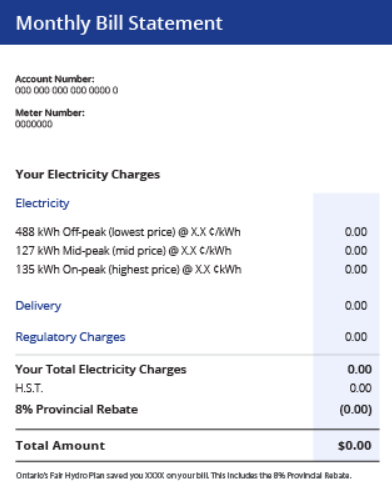
You tin can calculate your annual free energy by calculation up the amount shown for 12 sequent months. Don't make the mistake of multiplying a unmarried month by 12 – usage fluctuates greatly depending on the season.
You can summate the size of the solar power system that y'all'll demand with the following equation:
Size of system needed (kW) = yearly energy use (kWh) / almanac equivalent full sunlight hours (h)
(annual average 'equivalent total sunlight hours' in Ontario = 1,166h)
For case, let's pretend that yous added upwardly your power bills and determined that you use 10,000kWh over the course of a yr. Y'all would then exercise the in a higher place calculation and determine that you demand a 8.58kW solar panel system!
10,000kWh / i,166h = 8.58kW
2. Physical Sizing
Now that yous know the size of your system in units of kW, yous tin determine how much space the system volition require by converting it to units of sqft.
The boilerplate solar console is approximately 18sqft in size (including some buffer room for racking and spacing) and produces about 300watts of power.
The equation to summate the infinite that your solar system require is once again simple:
Physical space required = size of organisation needed (in kW) / size of panel (in kW) * physical size of console (in sqft)
(average size of panel = 0.3kW, average physical panel size = 18sqft)
Let's go along from the previous section and presume that you demand a eight.58kW system. You would practise the in a higher place calculation and determine that you demand 515sqft of space to install your system!
eight.58kW / 0.3kW * 18sqft = 515sqft
(annotation that 300watts equals 0.3kW)
If you're putting solar panels on your roof, you should know that:
- A s facing roof is all-time, east and due west facing are proficient, merely north is not keen
- You may need to replace your shingles (or entire roof) earlier installing – considering panels are guaranteed for 25 years!
If yous're putting solar panels on the ground, you should know that:
- These systems are more than expensive upfront due to piling, mounting , and trenching requirements
- They are more efficiency because they tin be hands placed to the optimal direction (s), the optimal angle (~45°), and to avert shading
- Thus, these systems are more than efficient and have better lifetime IRRs and NPVs.
Most residential homeowners in Ontario put solar panels on their roof. Rural holding owners put systems on the roof of their house or shop – or on the ground in their yard.
3. Organization Costs
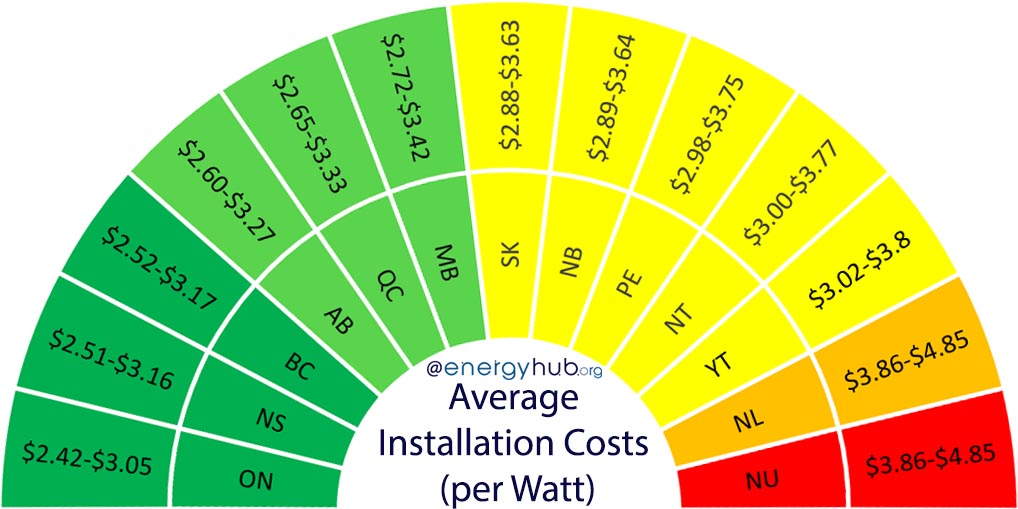
The concluding piece of bones information that you'll want to know is an approximation of how much your system will price. To calculate this, you just need to know the size of the system in units of kW.
The rough calculation is elementary. Just accept the size of your organisation and multiply it by the $2.46/watt – the boilerplate cost of installing a solar arrangement in Ontario.
You can summate your total system costs with the following equation:
System cost = size of organization needed x cost per installed watt
Continuing with our previous example, we tin can encounter that a eight.58kW system would cost approximately $21,107 to install.
= eight,580watts ten $ii.46/watt
= $21,107
Note that the exact price of the system depends on several factors including the system size, the quality of equipment used, and the complexity of the task.
Fifty-fifty the range in the chart in a higher place is just an average – installation prices tin can easily go as loftier equally $3.00+/watt for premium equipment and high quality installers.
Ready to get started? And so become a free personalized cost estimate:
Become a cost estimate
Overall Ranking

Every year, we score every province and territory in Canada on the relative feasibility of installing a solar power organisation. This year, Ontario scores #9, receiving a full score of 59/100.
The remainder of this guide explores each ranking gene individually, while too providing important information nigh installing solar in Ontario.
(if y'all want to learn how we score each factor, please visit our Provincial Solar Rankings page)
Solar Incentives
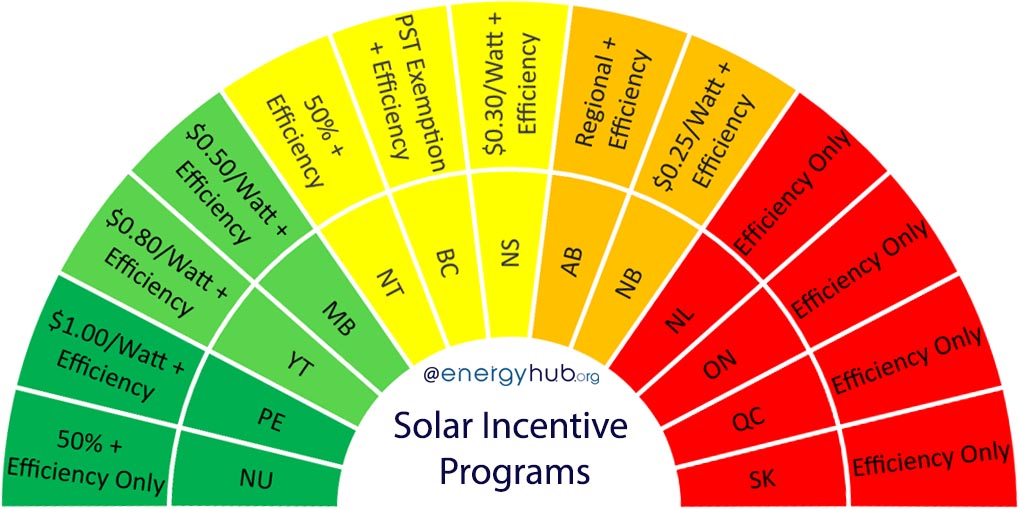
Major Programme: None
Savings: None
Ontario does not currently accept any solar incentive programs. These factors are important because they reduce the upfront organisation costs. We've scored Ontario 0/20 for this department.
Rebates & Taxation Breaks
The merely solar rebate program that was available to Ontario homeowners was the GreenOn Solar Rebate Program – however, this was cancelled past the current conservative provincial government.
Businesses can now apply the Federal Tax Provision for Clean Energy Equipment to fully expense their solar system. This means a CCA charge per unit of 100% and the abolishment of the first-year rule.
Other Clean Energy Incentives
There are at least 4 other free energy incentive programs available in Ontario. While not considered in our solar rankings, many homeowners cull to leverage these (i.e., home energy efficiency incentives) around the same time they switch to solar.
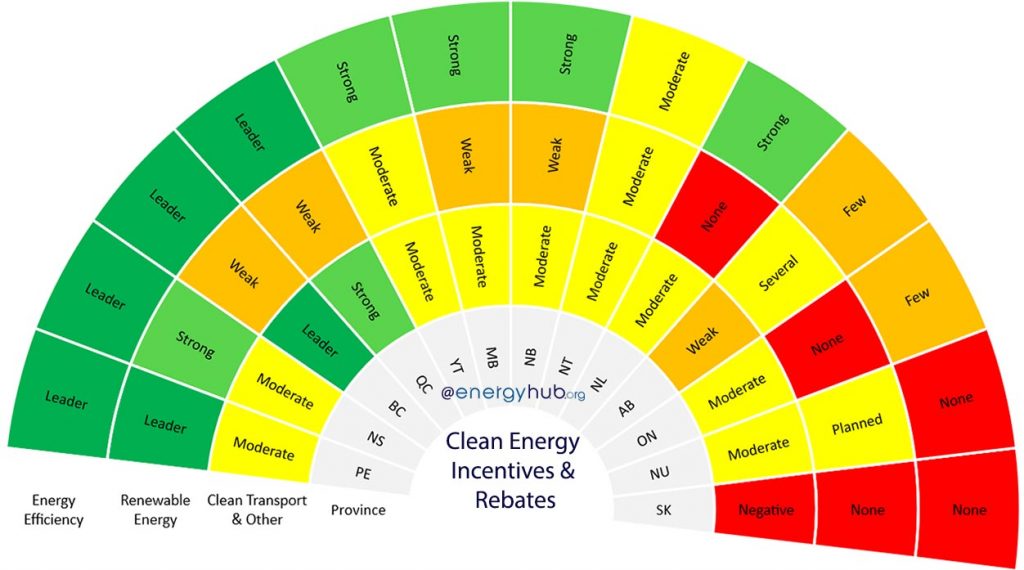
Natural Factors
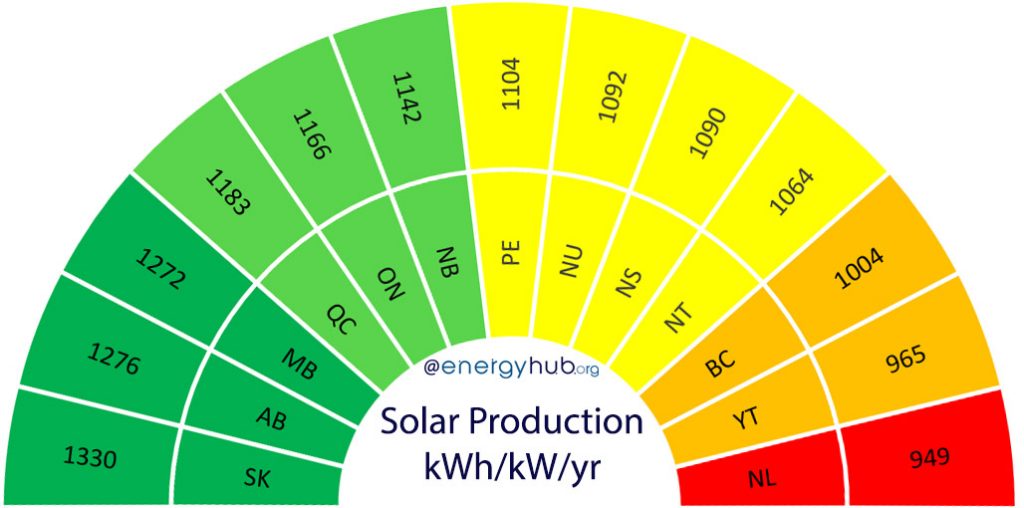
Production Potential: 1166kWh per kW per year
Ontario is one of the best provinces in terms of the natural factors that influence the maximal corporeality of free energy that a system tin can produce. We've scored Ontario 17.5/20 for this section.
Solar Irradiance
Ontario has the fifth-highest potential to produce solar free energy in all of Canada, receiving more solar irradiation than most other provinces except for the prairies and Quebec!
According to data from Natural Resources Canada, the average solar system in Ontario tin produce 1166kWh of electricity per kW of solar panels per year.
Here is how much an average solar system can produce each month, as well as the solar irradiance potential map for Ontario:
This yearly average decreases as y'all move north in the province and increases every bit you move southward. For example, a 1kW solar arrangement in:
- Toronto would produce nigh i,163 kWh/yr
- Ottawa would produce about one,199 kWh/year
- Mississauga would produce well-nigh 1,160 kWh/yr
- Brampton would produce about one,155 kWh/twelvemonth
- Hamilton would produce 1,152 kWh/yr
Recall that this is the number we used in the System Sizing section!
(maps and solar irradiance information for all other provinces and territories can be found on our Solar Maps page.)
Utility Policies
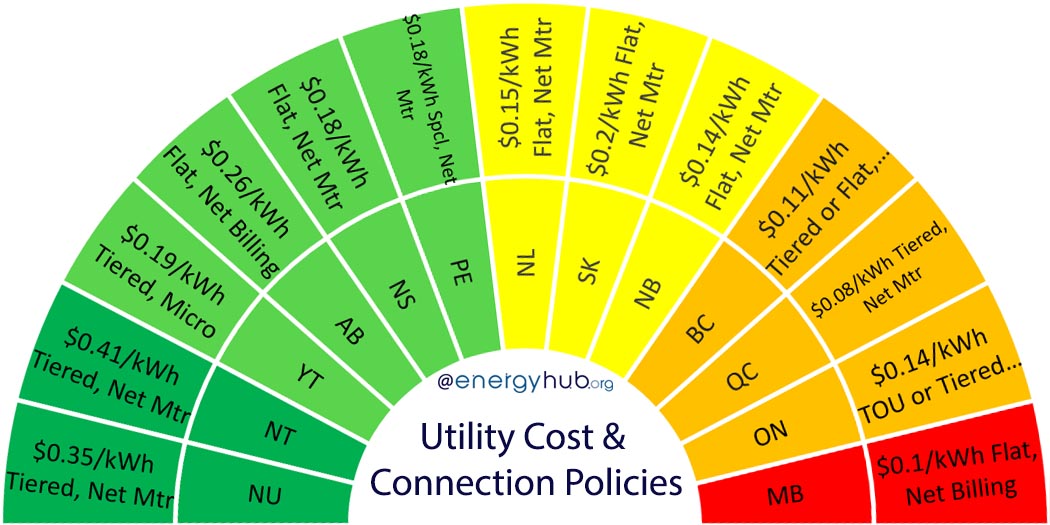
Connection Policy: Cyberspace Metering
Rate Pattern: $0.xiii/kWh, Tiered
Ontario scores behind almost of the provinces when it comes to utility-related factors.
Utility factors determine how much money your utility will pay you for the power you produce, along with how much money you will save on your power bill by reducing your usage. We've scored Ontario 22/30 for this section.
Interconnection Policy
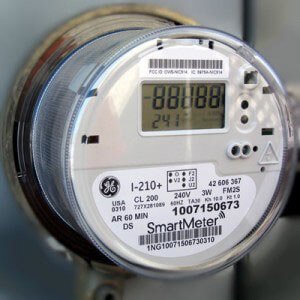
Net Metering is one of the near of import policy mechanisms that makes solar a viable energy generation selection.
Net Metering essentially means that you earn credits for the excess energy that you produce, which can then be used at a later time. Information technology'south mutual to produce excess energy during the solar day and summertime but non enough at night and during the winter – and so this policy is important!
Good net metering policy allows you to earn full credits for your excess energy which can be carried month-to-calendar month. Bad net metering policy allows y'all to earn only partial credits for excess free energy and credits can't be carried forrard calendar month-to-calendar month.
Ontario'southward Net Metering Programme falls in the "proficient" category for net metering policies. It allows for any size of system to be connected to the grid (but utilities can request smaller sizer) and credits tin be carried frontward month-to-month.
However, it'southward important to note that internet-metering credits in Ontario expire yearly. Thus, you lot'll desire to work closely with your installer to brand certain your system perfectly matches your energy usage.
Solar Setup Fees
Solar setup fees vary profoundly beyond the province. For example, if you lot're a Hydro I customer you don't have to pay anything, but if you're a Guelph Hydro customer y'all accept to pay $ane,700 for an interconnection study and a bi-directional meter.
This is opposed to several other provinces similar Alberta and British Columbia where there are no setup fees for anyone.
Electricity Prices

Ontario enjoys some of the everyman electricity prices in the land – merely lower prices hateful lower savings potential when you switch to solar.
Based on a monthly usage of 1,000kWh, the boilerplate total cost of electricity in Ontario is $0.130/kWh (this number includes both fixed and variable costs).
This number is college than the Canadian average of $0.138/kWh (excluding the territories), pregnant that property owners in Ontario accept moderate savings potential!
(methodology and data on other provinces and territories tin can be institute on our Electricity Prices page.)
Utility Pecker Charge per unit Blueprint
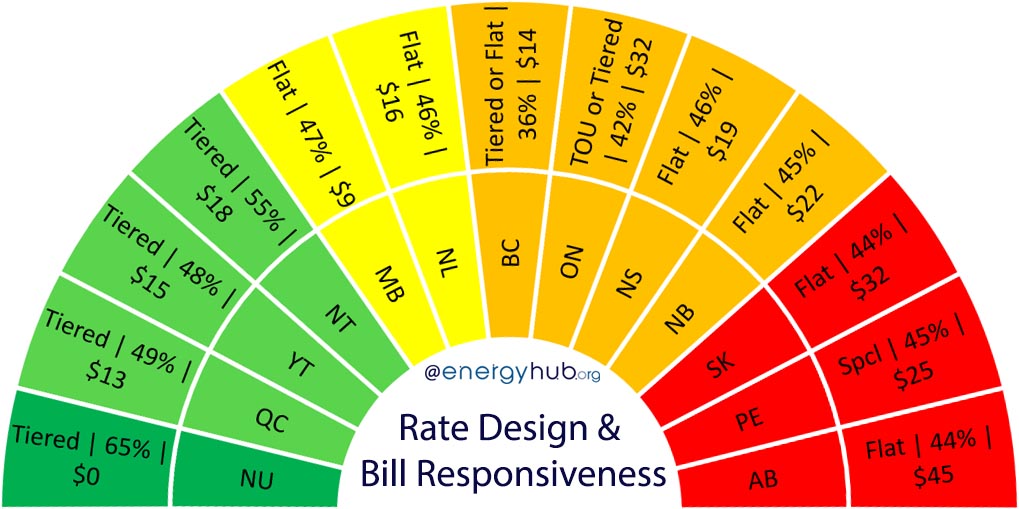
Expert electricity charge per unit design allows you to relieve coin when you save energy. This might sound intuitive – but non all provinces are same. Superior designs have low stock-still monthly fees and tiered electricity rates. Junior designs have high fixed fees and apartment electricity rates.
Ontario scores well-nigh the forepart of the pack when information technology comes to these factors – having time-of-apply rates and fixed monthly fees of $26 (taking into account Ontario's electricity rebate).
For example, reducing your electricity beak from 1,500 to 750 kWh per month volition save y'all 54% on your electricity pecker in British Columbia, 48% in Nova Scotia, but only 43% in Ontario!
Notation that fixed monthly fees don't disappear even if you lot switch to solar – you'll pay them equally long as y'all remain continued to the grid. But this isn't a bad thing – $26/mo is a small price to pay for using the filigree equally your back-up energy source!
(methodology on our Electricity Prices folio.)
The only way to completely remove your fixed costs is to go off the filigree, something nigh homeowners in Ontario don't do because of high bombardment costs.
Disconnecting from the grid also means that you won't be able to participate in your utility's internet metering programme.
System Financing
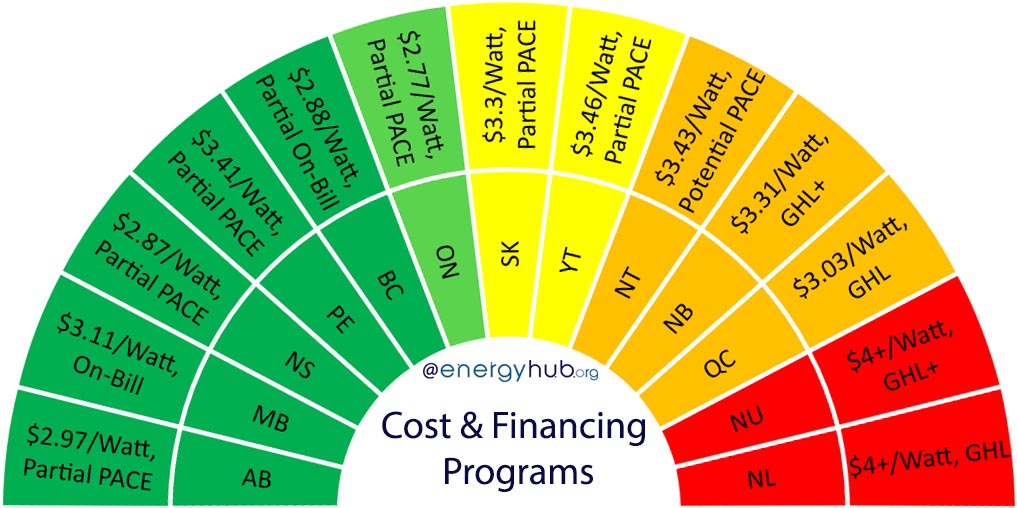
Upfront Cost: $2.46/watt
Financing: Fractional PACE
Ontario is the all-time province in the state when it comes to financial factors because of low up-front costs and PACE financing options in Toronto. We've scored Ontario 19/xxx for this department.
Cost of Installation
The upfront cost of installation is evidently 1 of the largest factors that make up one's mind whether or not a person is going to switch to solar. The electric current boilerplate price range in Ontario is virtually $2.34-$2.59/kW.
(not sure what this number means or how to utilise it? Jump support to the Common Questions section.)
However, the price can easily be higher or lower depending on the size of the system, the complexity of the task, the type of equipment used, and even on the quality of your installation company.
In general, aiming for the cheapest price shouldn't be your goal. Virtually solar panels are guaranteed to concluding for 25 years, so yous want to make sure that your installation job is good enough to support that.
Y'all'll also want to be certain that the company you lot choose will exist around in 5 to 10 years from now in instance you lot need service or warranty work washed. If you get a quote through us, we'll connect you with a pre-vetted installer!
PACE Programs
Property Assessed Clean Free energy (Footstep) is an innovative financing option that allows you to cover the unabridged upfront cost of your solar system (or energy efficiency upgrades) with a $0 down, long amortization period, depression interest 'loan'.
All the same, unlike a typical loan, this loan is fastened to your property (non you) and is paid back on your property taxation beak as a Local Improvement Charge (LIC). The only eligibility is that you need to own a sure portion of your home.
While the legislation does be in Ontario for Stride financing, the only major example of a municipality actually enabling it is the Abode Free energy Loan Program in Toronto.
Guelph may as well exist enacting a Footstep program in the well-nigh future.
Other Energy Financing
Obviously though, PACE is not the but mode to finance a solar arrangement. Systems can exist financed by cash, bank loans, installer financing, home equity loans, a home disinterestedness line of credit, a mortgage (for new builds), or through energy loans.
Other options for Ontario homeowners:
- RBC Energy Saver Loan (energy loan)
- Up to ten years amortization
- RBC contact number: 1-800-769-2511
Solar Power Ontario
Because of good financing options, lowest installation costs, only a lack of incentives – nosotros rank Ontario as being the #9 best province in the land for switching to solar power.
Ready to get started? Then get a free personalized cost estimate:
Get a price estimate
Source: https://www.energyhub.org/ontario/
0 Response to "A Review of the Criteria for Locating of Solar Power Plants in Iran"
Post a Comment